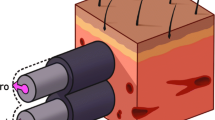Abstract
One reason given for placing capacitors in series with stimulation electrodes is that they prevent direct current flow and therefore tissue damage under fault conditions. We show that this is not true for multiplexed multi-channel stimulators with one capacitor per channel. A test bench of two stimulation channels, two stimulation tripoles and a saline bath was used to measure the direct current flowing through the electrodes under two different single fault conditions. The electrodes were passively discharged between stimulation pulses. For the particular condition used (16 mA, 1 ms stimulation pulse at 20 Hz with electrodes placed 5 cm apart), the current ranged from 38 to 326 μA depending on the type of fault. The variation of the fault current with time, stimulation amplitude, stimulation frequency and distance between the electrodes is given. Possible additional methods to improve safety are discussed.








Similar content being viewed by others
References
Agnew WF, McCreery DB, Yuen TG, Bullara LA (1993) MK-801 protects against neuronal injury induced by electrical stimulation. Neuroscience 52(1):45–53
Brindley GS, Polkey CE, Rushton DN (1982) Sacral anterior root stimulators for bladder control in paraplegia. Paraplegia 20(6):365–381
Brummer S, Turner M (1975) Electrical stimulation of the nervous system: the principle of safe charge injection with noble metal electrodes. Bioeletrochem Bioenerg 2(1):13–25
Butterwick A, Vankov A, Huie P, Freyvert Y, Palanker D (2007) Tissue damage by pulsed electrical stimulation. IEEE Trans Biomed Eng 54(12):2261–2267
Donaldson N, Donaldson PEK (1986) When are actively balanced biphasic (‘Lilly’) stimulating pulses necessary in a neurological prosthesis? II pH changes; noxious products; electrode corrosion; discussion. Med Biol Eng Comput 24(1):50–56
European Standard (1998) EN45502-1 for safety, marking and information to be provided by the manufacturer in Active Implantable Medical Devices. CENELEC, Brussels, p 8
Gilad O, Horesh L, Holder DS (2007) Design of electrodes and current limits for low frequency electrical impedance tomography of the brain. Med Biol Eng Comput 45(7):621–633
Hernández-Labrado GR, Polo JL, López-Dolado E, Collazos-Castro JE (2011) Spinal cord direct current stimulation: finite element analysis of the electric field and current density. Med Biol Eng Comput 49(4):417–429
Huang CQ, Shepherd RK, Carter PM, Seligman PM, Tabor B (1999) Electrical stimulation of the auditory nerve: direct current measurement in vivo. IEEE Trans Biomed Eng 46(4):461–470
Hurlbert RJ, Tator CH, Theriault E (1993) Dose-response study of the pathological effects of chronically applied direct current stimulation on the normal rat spinal cord. J Neurosurg 79(6):905–916
Kane MJ, Breen PP, Quondamatteo F, ÓLaighin G (2011) BION microstimulators: a case study in the engineering of an electronic implantable medical device. Med Eng Phys 33(1):7–16
Langlois PJ, Demosthenous A, Pachnis I, Donaldson N (2010) High-power integrated stimulator output stages with floating discharge over a wide voltage range for nerve stimulation. IEEE Trans Biomed Circuits Syst 4(1):39–48
Liu X, Demosthenous A, Donaldson N (2008) An integrated implantable stimulator that is fail-safe without off-chip blocking-capacitors. IEEE Trans Biomed Circuits Syst 2(3):231–244
Loeb GE, Peck RA, Moore WH, Hood K (2001) BION system for distributed neural prosthetic interfaces. Med Eng Phys 23(1):9–18
Merrill DR, Bikson M, Jefferys JGR (2005) Electrical stimulation of excitable tissue: design of efficacious and safe protocols. J Neurosci Methods 141(2):171–198
Ortmanns M, Rocke A, Gehrke M, Tiedtke H-J (2007) A 232-channel epiretinal stimulator ASIC. IEEE J Solid-State Circuits 42(12):2946–2959
Schuettler M, Franke M, Krueger TB, Stieglitz T (2008) A voltage-controlled current source with regulated electrode bias-voltage for safe neural stimulation. J Neurosci Methods 171(2):248–252
Shepherd RK, Linahan N, Xu J, Clark GM, Araki S (1999) Chronic electrical stimulation of the auditory nerve using non-charge-balanced stimuli. Acta Otolaryngol 119(6):674–684
Tripolar book electrodes, Finetech Medical Ltd, 13 Tewin Court, Welwyn Garden City, Hertfordshire, AL7 1AU, United Kingdom
Vanhoestenberghe A (2007) Implanted devices: improved methods for nerve root stimulation. PhD Thesis, University College London, London, United Kingdom
Acknowledgments
The authors thank Prof. Stéphane Godet and Benoit Haut for their help on this study.
Author information
Authors and Affiliations
Corresponding author
Rights and permissions
About this article
Cite this article
Nonclercq, A., Lonys, L., Vanhoestenberghe, A. et al. Safety of multi-channel stimulation implants: a single blocking capacitor per channel is not sufficient after single-fault failure. Med Biol Eng Comput 50, 403–410 (2012). https://doi.org/10.1007/s11517-012-0889-5
Received:
Accepted:
Published:
Issue Date:
DOI: https://doi.org/10.1007/s11517-012-0889-5




